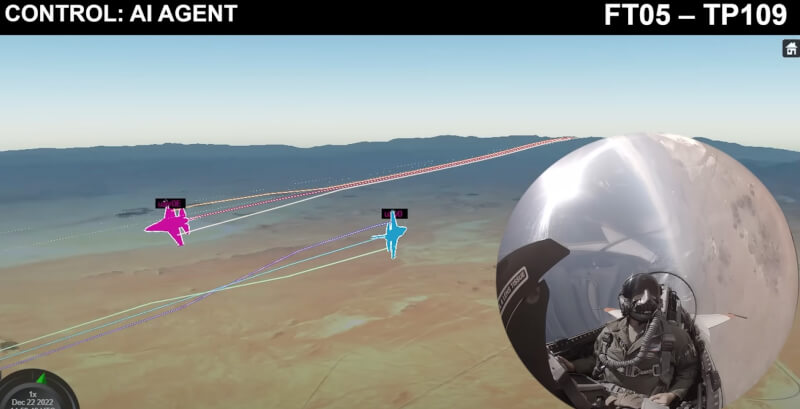AI moves into fighters and wins

For the first time ever, an AI fighter pilot faced off against a human pilot in a "dogfight" using actual fighter jets in the air, a huge milestone in autonomous flight and military automation. "The X-62A team has demonstrated that state-of-the-art machine learning-based autonomy can be safely applied to fly dynamic combat maneuvers," said Frank Kendall, Secretary of the Air Force. "The team achieved this while adhering to US standards for the safe and ethical use of autonomous technology."
AI-controlled aircraft can be an advantage for the military. Not only can they reduce injuries and accidents for pilots, but AI also has the potential to quickly analyze large amounts of data, enabling faster and more informed decisions. " The best pilot you'll ever find will take a few tenths of a second to do something," Kendall said in 2023. "AI will do it in a microsecond, it'll be a completely different level of performance."
But before the military can hand AI control over fighter jets, they need to be sure the systems can be trusted to do what they're supposed to. That means not only completing their objectives, but doing so in a manner that follows the same rules of safety and ethics that Air Force pilots follow.
The top AIs defeated the human pilot 5-0 in the championship match. DARPA (Defense Advanced Research Projects Agency) decided to test the concept by training an AI to operate a fighter jet during a close combat with another aircraft, also known as a dogfight. " Dogfighting is extremely dangerous, so if machine learning can work effectively in such a dangerous environment as air-to-air combat, it has great potential to gain the trust of humans," said Col. James Valpiani, Commandant of the Air Force Test Pilot School.
In 2019, DARPA launched the Air Combat Evolution (ACE) program to develop its AI fighter pilot, and in 2020, eight teams competed in the AlphaDogfight Trials Final, pitting their trained AIs against each other, and a real human pilot, in simulated dogfights. The best of these AIs defeated the human pilot 5-0 in the championship match.
The physics of the real world are incredibly difficult to simulate, leading to a phenomenon known as the "sim-to-real" gap, where an AI does not perform as well as in simulations when given control of something real. DARPA had to give its AI fighter pilot control of a real fighter jet to find out if it was up to the task.
This they did for the first time in December 2022 using a modified F-16, known as the X-62A or VISTA ("Variable In-flight Simulator Test Aircraft"). "We didn't run into any major problems, but we encountered some differences with the results from the simulations, which is to be expected when going from a virtual to a live situation," said Lt. Col. Ryan Hefron, DARPA program manager for ACE, after those flights.
In September 2023, the ACE team decided that their AI fighter pilot was ready for a dogfight against a human F-16 pilot, and it performed exactly as hoped during the combat scenario, safety pilots were on board VISTA, but they never had to take control above the plane.
"We gradually built up safety with the maneuvers: first defensive, then offensive, then high-aspect nose-to-nose combat, getting very close to 2,000 feet at 1,200 miles per hour," said Lt. Col. Maryann Karlen, deputy commandant of the Air Force Test Pilot School.
The ACE team won't reveal who won these first dogfights between their AI fighter pilot and the human pilot, but they have said they plan to continue testing through 2024 and apply what they learn from the dogfights to other types of scenarios. " Dogfighting was the problem that needed to be solved so we could start testing autonomous artificial intelligence systems in the air," said Bill Gray, chief test pilot at the Air Force Test Pilot School. "Every lesson we learn applies to any task you might give to an autonomous system."
Latest gadgets
-
30 Aprfitness
-
29 Aprgadgets
Tesla clears regulatory hurdles in China
-
26 Aprgadgets
ASUS TUF Gaming Capture Box-4K Pro
-
25 Aprgadgets
Apple Watch Series 10: Thinner with new technology
-
24 Aprgadgets
AI deepfakes threaten global elections
-
23 Aprgadgets
AI moves into fighters and wins
-
23 Aprgadgets
Meta opens up VR software to other companies
-
23 Aprgadgets
Is Apple Vision Pro already forgotten?
Most read gadgets
Latest gadgets
-
30 Aprfitness
Healthy lifestyle can counteract genetics
-
29 Aprgadgets
Tesla clears regulatory hurdles in China
-
26 Aprgadgets
ASUS TUF Gaming Capture Box-4K Pro
-
25 Aprgadgets
Apple Watch Series 10: Thinner with new technology
-
24 Aprgadgets
AI deepfakes threaten global elections
-
23 Aprgadgets
AI moves into fighters and wins
-
23 Aprgadgets
Meta opens up VR software to other companies
-
23 Aprgadgets
Is Apple Vision Pro already forgotten?






